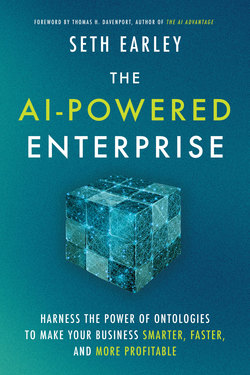Читать книгу The AI-Powered Enterprise - Seth Earley - Страница 7
На сайте Литреса книга снята с продажи.
ОглавлениеFOREWORD
When I think of Seth Earley, I think of four things: knowledge exchange “salons” around the firepit at his home, a crazy-fast and small racing-power catamaran on which I risked my safety with him, knowledge management, and conversational artificial intelligence. I won’t elaborate further on the first two, but the last two are highly relevant to this book. Like me, Earley spent a number of years consulting and writing about knowledge management. That topic isn’t terribly popular now, but it has positively informed his approach to AI and this book.
The book is heavily focused on the importance of ontologies in conversational AI systems, and ontologies were also very important in knowledge management. Of course, the ontology Earley is addressing is not the metaphysical study of the nature of being. The other meaning of ontology is, to use Google’s definition, “a set of concepts and categories in a subject area or domain that shows their properties and the relations between them.” Earley is convinced, as am I, that you can’t create an effective conversational AI system—a chatbot, an intelligent agent, or a virtual assistant—without an ontology. And if you want a practical introduction to ontologies and their application in conversational AI, you have come to the right place.
I have always liked Seth’s favorite line of, “There is no AI without IA,” where “IA” is information architecture—another term for ontology. It’s both catchy and mostly true. Of course, as an academic (though a pretty practical one), I am inclined to look for exceptions to general rules, and I think there are some exceptions to that sensible rule.
You will note in this book that the primary examples of AI that Earley uses are the conversational approaches that organizations are widely adopting for interactions with customers and employees. His appealing rule about AI and IA is true for the great majority of conversational AI applications. Perhaps there are exceptions to it if you include, for example, statistical translation programs like Google Translate in the category of conversational AI. I’m not sure they belong in the category, but they do facilitate conversation with speakers of other languages.
The other exception domain is also debatable. I have argued with Seth that machine learning—statistical approaches to prediction and classification that many observers include as AI—doesn’t necessarily demand an ontology. It requires data (often great heaping gobs of it) on multiple variables (also called features) in rows and columns, but we don’t need to know the terminological relationships between them.
But Earley’s counterargument is that if you are managing enterprise data, it is hugely beneficial to have an ontology that describes what data entities you have in your organization and how they relate. If you have a customer ID data element, for example, it’s very useful to know that it includes current customers, former customers, and prospects, and that customer orders are aggregated by that ID. Earley has a particular passion for customer and product data, and I agree that they are perhaps the most important types for most organizations.
I am not a fan of massive projects to create enterprise-level ontologies (often known as “master data management” or “enterprise information architecture” projects), but there is no doubt that your organization should know what data elements you have access to, and how they relate to other data. And I believe that ontology efforts are of more value if they are relatively narrow in scope. So I partially concede the argument to Earley even for machine learning. And in the book he describes a “bottom-up, data-and content-centric” approach to creating ontologies, which I generally believe is more effective.
In any case, there is far more to this book than urgings about ontology. It also addresses such topics as the critical role of data in digital transformation, techniques like tagging data with metadata, organizational challenges for effective data, and the role of data in the customer experience. My favorite story in that regard involves granite countertop cleaners, but I won’t spoil your suspense by relating it.
A great strength of the book is that it is replete with such examples from Earley’s experience and the work of his consulting firm. He has worked with companies across many different industries—many of them very large and successful firms—that had problems with their data in the context of AI. His firm has built successful and sophisticated intelligent agent or chatbot systems for both customers and employees.
I have written two books on AI and read many more, and I do not know of any books that have such useful and detailed advice on the relationship between data and successful conversational AI systems. If that’s what you need, read on.
Thomas H. Davenport
President’s Distinguished Professor at Babson College, Research Fellow at MIT Initiative on the Digital Economy, and author of Only Humans Need Apply and The AI Advantage
